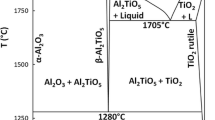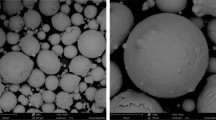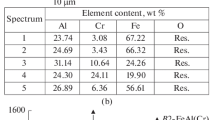A phase change from α-alumina (corundum) in the feedstock powder to predominantly other alumina phases, such as γ-alumina in the coating normally takes place, as a result of the spray process. It is expected that the prevention of this phase transformation will significantly improve the mechanical, electrical, and other properties of thermally sprayed alumina coatings. The results regarding the possibility of stabilization of α-alumina through addition of chromia published in the literature are ambiguous. In this work, stabilization using different spray processes (water-stabilized plasma (WSP), gas-stabilized plasma (APS), and high-velocity oxy-fuel spray (HVOF)) was studied. Mechanical mixtures of alumina and chromia were used, as were prealloyed powders consisting of solid solutions. The investigations focused on mechanical mixtures with both APS and WSP and on prealloyed powders with WSP. The coatings were studied by x-ray diffraction, including Rietveld analysis, and analysis of the lattice parameters. Microstructures were investigated by optical microscopy using metallographic cross-sections. It was shown that in the case of the mechanically mixed powders, the stabilization predominantly depends on the applied spray process. The stabilization of the α phase by use of the WSP process starting from mechanical mixtures was confirmed. It appears that stabilization exhibits a complex dependence on the spray process, the process parameters (in particular the thermal history), the nature of the powder (mechanically mixed or prealloyed), and the chromia content.












Similar content being viewed by others
References
N.N. Ault, Characteristics of Refractory Oxide Coatings Produced by Flame Spraying, J. Am. Ceram. Soc., 1957, 40(3), p 69-74
R. McPherson, Formation of Metastable Phases in Flame- and Plasma-Prepared Alumina, J. Mater. Sci., 1973, 8(6), p 851-858
R. McPherson, A Review of Microstructure and Properties of Plasma Sprayed Ceramic Coatings, Surf. Coat. Technol., 1989, 39/40(1-3), p 173-181
B. Dzur, Ein Beitrag zur Anwendung des induktiv gekoppelten Hochfrequenz-Plasmas zum atmosphärischen Plasmaspritzen oxidkeramischer Werkstoffe (A Contribution to the Application of Inductively Coupled HF-plasma to Atmospheric Plasma Spraying of Ceramic Oxide Materials), Dissertation, TU Ilmenau, 2002 (in German)
B. Dzur, Das thermische, induktiv gekoppelte Hochfrequenzplasma: Grundlagen und Möglichkeiten einer außergewöhnlichen Technologie (The Thermal, Inductively Coupled HF-Plasma: Basics and Possibilities of an Extraordinary Technology), Jahrbuch Oberflächentechnik 2006, R. Suchentrunk, Ed., Bad Saulgau, Eugen G. Leuze Verlag, 2006, 62, p 131-142, in German
G.N. Heintze, S. Uematsu, Preparation and Structures of Plasma-Sprayed γ- and α-Al2O3 Coatings, Surf. Coat. Technol., 1992, 50(3), p 213-222
H. Kreye, Herstellung von Aluminiumoxidschichten mit verbesserten Eigenschaften (Preparation of Alumina Coatings with Improved Properties), University of the Federal Armed Forces Hamburg, Institute for Materials Technologies, Final Report, AiF-founded Project No. 11.466 N, 01.01.1998-31.12.1999, in German
R. McPherson, On the Formation of Thermally Sprayed Alumina Coatings, J. Mater. Sci., 1980, 15(12), p 3141-3149
R.S. Lima, C.P. Bergmann, Phase Transformations on Flame Sprayed Alumina, Thermal Spray: Practical Solutions for Engineering Problems, C.C. Berndt, Ed., (Cincinnati, OH), ASM International, 1996, p 765-771
K. Niemi, P. Vuoristo, T. Mäntylä, E. Lugscheider, J. Knuuttila, H. Jungklaus, Wear Characteristics of Oxide Coatings Deposited by Plasma Spraying, High Power Plasma Spraying and Detonation Gun Spraying, Advances in Thermal Spray Science & Technology, C.C. Berndt, S. Sampath, Ed., (Houston, TX), ASM International, 1995, p 645-650
J. Dubsky, V. Brozek, B. Kolman, and P. Chraska, Stabilization of α-Al2O3 Plasma Sprayed Coatings by Chromia, Ceramics, adding the value: AUSTCERAM 92, International Ceramic Conference, M.J. Bannister, Ed., Melbourne, 1992, p 793-797
S. Costil, B. Normand, C. Coddet, A.B. Vannes, Alumina Plasma Sprayed Coatings Submitted to Cyclic Tribological Solicitations: Effect of TiO2 Content, International Thermal Spray Conference, E. Lugscheider, C.C. Berndt, Ed., (Essen, Germany), Düsseldorf, DVS-Verlag, 2002, p 944-948
J. Ilavsky, C.C. Berndt, H. Herman, P. Chraska, J. Dubsky, Alumina-Base Plasma-Sprayed Materials—Part II: Phase Transformation in Aluminas, J. Therm. Spray Technol. 1997, 6(4), p 439-444
R. Venkataraman, P. Singh, R. Krishnamurthy, Enhanced α Phase Stability During Plasma Spraying of Alumina-13 mol% Titania, J. Am. Ceram. Soc., 2006, 89(2), p 734-736
H. Saalfeld, Strukturuntersuchungen im System Al2O3-Cr2O3 (Structural Investigations in the Al2O3-Cr2O3 System), Z. Kristallogr., 1964, 120, p 342-348, in German
K. Wefers and C. Misra, Oxides and Hydroxides of Aluminum, Alcoa Technical Paper, 19, Pittsburgh: Aluminum Company of America, 1987, 92 p
L.R. Rossi, W.G. Lawrence, Elastic Properties of Oxide Solid Solutions: The System Al2O3-Cr2O3, J. Am. Ceram. Soc., 1970, 53(11), p 604-608
M. Watanabe, T. Hirayama, M. Yoshinaka, K. Hirota, O. Yamaguchi, Formation of Continuous Series of Solid Solutions from Powders Prepared by Hydrazine Method: The System Cr2O3-Al2O3, Mater. Res. Bull., 1996, 31(7), p 861-868
W. Sitte, Investigation of the Miscibility Gap of the System Chromia-Alumina below 1300 °C, Reactivity of Solids, Part A, Mater. Sci. Monographs, 1985, 28A, p 451-456
E.N. Bunting, Phase Equilibria in the System Cr2O3-Al2O3, J. Res. Natl. Bur. Stand. (U.S.), 1931, 6(6), p 947-949
P. Chráska, J. Dubský, K. Neufuss, J. Písacka, Alumina-Base Plasma-Sprayed Materials Part I: Phase Stability of Alumina and Alumina-Chromia, J. Therm. Spray Technol. 1997, 6(3), p 320-326
J. Dubský, V. Řídký, B.J. Kolman, and P.J. Chráska, 2004, Properties of Plasma Sprayed Alumina-Chromia Mixtures, Thermal Spray 2004: Advances in Technology and Application, ASM International, May 10-12, 2004 (Osaka, Japan), Düsseldorf, DVS-Verlag, 4 p
J. Dubský, B. Kolman, V. Brozek, and P. Chráska, The Chemical Inhomogeneity of Al2O3-Cr2O3 Powders for Plasma Spraying, Proc. of 16th Symposium on Plasma Physics and Technology, Czech Technical University, Prague, Czechoslovakia, 1993, p 267-273
J.-H. Müller, H. Kreye, Mikrostruktur und Eigenschaften von thermisch gespritzten Aluminiumoxidschichten (Microstructure and Properties of Thermally Sprayed Alumina Coatings), Schweissen und Schneiden, 2001, 53(6), p 336-345, in German
J. Voyer, B.R. Marple, and C.-K. Jen, Plasma Sprayed Ceramic Coatings for Ultrasonic Wave Guidance in Severe Environments, United Thermal Spray Conference, E. Lugscheider and P.A. Kammer, Ed., March 17-19, 1999 (Düsseldorf, Germany), Düsseldorf, DVS-Verlag, 2002, p 630-635
B. R. Marple, J. Voyer, P. Béchard, Sol Infiltration and Heat Treatment of Alumina Chromia Plasma-Sprayed Coatings, J. Eur. Cer. Soc., 2001, 21(7), p 861-868
S. H. Yu and H. Wallar, Chromia Spray Powders and a Process for Making the Same, US 6,774,076, filed 03.09.2002, published 10.08.2004
S. H. Yu and H. Wallar, Chromia Spray Powders, US 7,012,037, filed 08.04.2002, published 14.03.2006
R.J. Damani, E.H. Lutz, Microstructure, Strength and Fracture Characteristics of a Free-Standing Plasma-Sprayed Alumina, J. Eur. Ceram. Soc., 1997, 17(11), p 1351-1359
R. McPherson, The Relationship between the Mechanism of Formation, Microstructure and Properties of Plasma Sprayed Coatings, Thin Solid Films, 1981, 83(3), p 297-310
Acknowledgments
The work of the Czech authors was supported by the Czech research foundation (GACR, project number 106/05/0483). The authors would like to thank Ms. B. Wolf (Fh-IWS) for metallographic preparation of the coatings.
Author information
Authors and Affiliations
Corresponding author
Additional information
This article is an invited paper selected from presentations at the 2007 International Thermal Spray Conference and has been expanded from the original presentation. It is simultaneously published in Global Coating Solutions, Proceedings of the 2007 International Thermal Spray Conference, Beijing, China, May 14-16, 2007, Basil R. Marple, Margaret M. Hyland, Yuk-Chiu Lau, Chang-Jiu Li, Rogerio S. Lima, and Ghislain Montavon, Ed., ASM International, Materials Park, OH, 2007.
Rights and permissions
About this article
Cite this article
Stahr, C., Saaro, S., Berger, LM. et al. Dependence of the Stabilization of α-Alumina on the Spray Process. J Therm Spray Tech 16, 822–830 (2007). https://doi.org/10.1007/s11666-007-9107-7
Received:
Revised:
Accepted:
Published:
Issue Date:
DOI: https://doi.org/10.1007/s11666-007-9107-7




